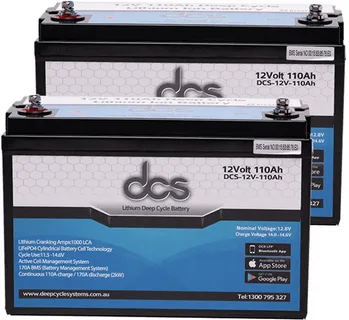In today’s world, where energy efficiency and sustainability are at the forefront of technological advancements, choosing the right power source for your needs is crucial. One such powerhouse of energy storage is the 120 amp deep cycle battery. Renowned for its longevity and ability to provide a steady power supply, this battery is essential for anyone looking to maximise energy efficiency in various applications.
Understanding Deep-Cycle Batteries
Understanding deep-cycle batteries is essential for effective energy management in various applications. Unlike traditional batteries designed for short bursts of power, deep-cycle batteries are specifically engineered to provide sustained energy over extended periods. This makes them ideal for use in recreational vehicles, marine applications, solar energy systems, and backup power solutions. Deep-cycle batteries are built to withstand repeated discharges and recharges, allowing them to operate efficiently in demanding conditions.
They typically have a higher amp-hour (Ah) rating, indicating their capacity to deliver consistent power. This design enables users to run multiple devices or systems simultaneously without the risk of damaging the battery. Two main types of deep-cycle batteries are flooded lead-acid and sealed lead-acid (AGM and gel). Each type has unique characteristics, including maintenance requirements, charging efficiency, and lifespan.
The Importance of Amp-Hours (Ah)
Amp-hours (Ah) are crucial for understanding battery capacity and performance. This unit quantifies the amount of electrical charge a battery can deliver over a specified period, indicating how long it can power a device before recharging. For instance, a 120-amp hour (Ah) battery can provide 120 amps for one hour or 60 amps for two hours.
This metric helps users determine the suitability of a battery for specific applications, such as recreational vehicles, marine use, or renewable energy systems. Understanding amp-hours is vital for managing energy consumption effectively. Users can match the battery capacity to their power needs, ensuring that devices operate smoothly without unexpectedly running out of power. Additionally, knowing the Ah rating aids in planning charging cycles and maintaining battery health, as deep discharges can shorten a battery’s lifespan.
Maximising Power: Choosing the Right Deep Cycle Battery Ah
Maximising power efficiency begins with choosing the correct deep-cycle battery Ah for specific energy needs. Understanding the amp-hour (Ah) rating is crucial, indicating how much energy a battery can deliver over a specified period. When selecting a deep-cycle battery, consider your energy requirements and usage patterns to determine the appropriate Ah rating that will provide reliable performance.
The deep cycle battery Ah should align with the devices you intend to power. For instance, a higher Ah rating will be necessary if you plan to run multiple appliances simultaneously or require longer usage times. Conversely, a lower Ah battery may suffice for less demanding applications. Consider the battery’s depth of discharge (DoD).
A battery with a higher DoD allows more stored energy to be utilised without damaging it, maximising its efficiency and lifespan. Moreover, compatibility with your charging system is essential. Ensure that the charging equipment can support the chosen deep-cycle battery Ah to avoid issues related to overcharging or undercharging, which can affect performance and longevity.
Key Features of a 120-Amp Hour Battery
A 120-amp hour (Ah) battery is designed for efficient energy storage and delivery, making it a popular choice for various applications. Here are some key features that define this type of battery:
- High Capacity: With a capacity of 120 amp hours, this battery can provide 120 amps of current for one hour or 60 amps for two hours, making it suitable for powering devices and appliances that require significant energy over an extended period.
- Deep-Cycle Design: A 120-amp hour battery is built to withstand deep discharges, allowing users to draw substantial power without damaging the battery. This feature is crucial for applications like RVs, marine use, and renewable energy systems, where batteries frequently undergo deep cycling.
- Versatility: This battery type is compatible with various charging systems, including solar, AC, and DC chargers. Its versatility makes it an excellent choice for users with multiple power sources.
- Durability: Many 120-amp hour batteries are designed with robust construction and advanced materials, enhancing their lifespan and reliability. Proper maintenance can further extend their longevity, making them a cost-effective option over time.
- Safety Features: Most models have essential safety features such as overcharge protection, short circuit protection, and temperature monitoring. These safeguards ensure safe operation and help prevent damage to the battery and connected devices.
Benefits of Deep Cycle Battery 120 Amp Hours
The deep-cycle battery 120-amp hours offers numerous benefits, making it an ideal choice for various energy needs. One of the primary advantages is its ability to provide sustained power over extended periods. Unlike standard batteries, designed for short bursts of energy, a deep-cycle battery is engineered to be discharged and recharged repeatedly, making it perfect for applications like recreational vehicles, marine systems, and off-grid solar setups.
Another significant benefit of the deep cycle battery 120 amp hours is its durability. These batteries are built to withstand the rigours of regular cycling, meaning they have a longer lifespan than conventional batteries. With proper maintenance, users can expect these batteries to last several years, providing reliable energy without frequent replacements.
Additionally, the deep-cycle battery 120-amp hours offers flexibility in power management. Its higher capacity allows users to run multiple devices or systems simultaneously, ensuring that essential appliances remain operational during outages or remote adventures. This capacity is particularly beneficial for those relying on renewable energy sources, as it can store excess energy for use during periods of low generation.
Applications of a 120-Amp Deep-Cycle Battery
A 120-amp deep-cycle battery is highly versatile and serves various applications across different sectors. Here are notable applications where this type of battery shines:
Recreational Vehicles (RVs)
A 120-amp deep-cycle battery is essential for powering various RV appliances, including lights, refrigerators, and air conditioning systems. Its ability to deliver a steady current over extended periods makes it ideal for off-grid camping and road trips.
Marine Use
Boaters rely on a 120-amp deep-cycle battery to power trolling motors, fish finders, and onboard electronics. This battery type can withstand deep discharges, making it perfect for extended fishing trips or leisurely outings on the water.
Renewable Energy Systems
In solar energy setups, a 120-amp deep-cycle battery stores energy generated during the day for use at night or during cloudy weather. Its capacity allows for significant energy storage, supporting home energy needs and promoting sustainability.
Electric Vehicles (EVs)
Many electric vehicles, including golf carts and electric bicycles, utilise a 120-amp deep-cycle battery to provide the necessary power. Its durability and reliability ensure consistent performance for daily commutes or recreational rides.
Backup Power Supply
A 120-amp deep-cycle battery can serve as a backup power supply during outages in homes and businesses. This application ensures that essential devices remain operational, providing peace of mind and security during unforeseen circumstances.
Maintenance Tips for Longevity
Maintaining a 120-amp deep-cycle battery maximises its lifespan and ensures optimal performance. Here are some essential maintenance tips to promote longevity:
- Regular Charging: Keep the battery charged, avoiding deep discharges. Recharge it after each use to prevent sulfation, which can degrade battery capacity.
- Use the Right Charger: Invest in a charger specifically designed for deep-cycle batteries. Ensure it matches the battery’s specifications to provide the correct voltage and charging rate.
- Monitor Water Levels: Regularly check the water levels for flooded lead-acid batteries and top them up with distilled water as needed. This helps maintain proper electrolyte levels and prevents damage.
- Clean Terminals: Keep the battery terminals clean and corrosion-free. Use baking soda and water to clean any buildup, and ensure that connections are tight to prevent voltage drops.
- Store Properly: If the battery is unused, store it in a cool, dry place. Avoid exposing it to extreme temperatures, which can negatively impact its performance and lifespan.
By following these maintenance tips, users can enhance the longevity of a 120-amp deep-cycle battery and ensure reliable power when needed.
Environmental Impact Of A 120 Amp Hour Deep Cycle Battery
The environmental impact of a 120 amp hour deep cycle battery can be significant, but with responsible use and disposal, it can be mitigated. These batteries often contain lead and acid, which can be harmful if incorrectly handled. Recycling is crucial; many components of the battery can be repurposed, reducing the need for raw materials and minimising waste. Proper disposal through designated recycling facilities ensures that toxic substances are managed safely, preventing contamination of soil and water sources.
Furthermore, the long lifespan of deep-cycle batteries contributes to environmental sustainability by reducing the frequency of replacements and the overall waste generated. Their efficiency in energy storage also supports renewable energy initiatives, such as solar and wind power systems, by providing a reliable way to store and use clean energy.
Advancements in battery technology continue to focus on reducing environmental impact. Innovations include the development of more sustainable materials and improvements in recycling processes. Users who choose a 120-amp hour deep-cycle battery support these advancements and contribute to a more sustainable energy future. Users can also minimise environmental impact through regular maintenance, ensuring the battery operates efficiently and lasts as long as possible.
Conclusion
In conclusion, a 120-amp deep-cycle battery is vital for meeting diverse energy needs, offering reliability and efficiency across various applications. Its capacity to deliver sustained power makes it ideal for recreational and emergencies. By understanding the benefits and features of this type of battery, users can make informed decisions that enhance their energy management strategies. Embracing such solutions ultimately leads to a more resilient and efficient energy system.
FAQs
What applications are suitable for a 120-amp deep-cycle battery?
A 120-amp deep-cycle battery is suitable for various applications, including powering electric trolling motors, solar power systems, and recreational vehicles. It is also commonly used in off-grid applications, ensuring energy is available for appliances and devices when needed.
How long can a 120-amp deep-cycle battery run devices?
The runtime of a 120-amp deep-cycle battery depends on the power consumption of the devices connected to it. For instance, if a device requires 60 watts, the battery can provide power for approximately 20 hours (120 amp-hours / 60 watts = 2 hours). However, the runtime may vary based on battery age and discharge rates.
What is the lifespan of a 120 amp deep cycle battery?
The lifespan of a 120 amp deep cycle battery typically ranges from 5 to 10 years, depending on usage patterns, maintenance, and charging practices. Proper care, such as avoiding complete discharges and using the correct charger, can significantly extend its lifespan.
How should a 120-amp deep-cycle battery be charged?
A 120-amp deep-cycle battery should be charged using a compatible charger designed for deep-cycle batteries. It is crucial to follow the manufacturer’s recommendations regarding voltage and charging cycles to ensure safe and efficient charging and thereby enhance battery life.
What maintenance is required for a 120-amp deep-cycle battery?
Regular maintenance for a 120-amp deep-cycle battery includes checking the water levels in flooded lead-acid models, cleaning the terminals to prevent corrosion, and ensuring the battery is securely mounted to avoid movement during use. Keeping the battery appropriately charged also helps maintain its performance and longevity.
| Related Business Listings |
| Contact Directory |
| Local Business Profiles |




